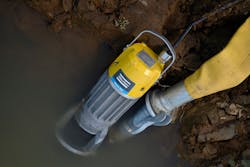Product Focus: Surface Pumps 101
Although surface pumps are versatile in their uses, you must make a careful choice if your main dewatering objectives are to be optimally achieved. These machines vary considerably in the technology that equips each one for a different set of jobs and circumstances. Here are some key considerations that will help you choose the right type of surface pump for your application.
1. Surface pump categories
Atlas Copco surface pumps are divided into the following ranges:
- Centrifugal dry prime (PAS): These pumps have a suction system that rapidly draws liquid in, eliminating the need for initial manual priming, which means you can start pumping from the moment you turn the switch. These pumps offer faster flow rates, higher lift capabilities, greater energy efficiency, and are suited to pumping larger volumes of liquid and handling bigger solid particles.
- Centrifugal wet prime (VAR): These pumps are more portable and are ideal for areas where access is difficult and terrain is rough. They are cheaper, easier to maintain, and offer a long and reliable service life even in tough conditions. Once filled, they are self-priming, provided the liquid level remains above their impeller.
- Wellpoint (WEL): In wellpoint dewatering, narrow shafts are injected into the ground to create small wells that are then connected to a pump to reduce the groundwater level when it is close to the surface or to remove water completely from a structure. The compact, robust WEL pumps use vacuum assistance and are technologically adapted to handling a high percentage of air. They are also fitted with filters to remove sand and other small solids.
2. Dewatering
Construction, quarrying, mining, and tunneling sites all have the issue of groundwater, which appears as excavation lowers the land surface. When alleviation of a heavy flood requires rapid removal of water, a powerful PAS dry prime pump is the obvious choice, especially when the water has a high solid content. A VAR pump is better suited for small or medium-sized floods in less accessible places.
Depending on the size of area involved, you can choose between WEL PST piston positive displacement models for lighter duties and higher-flow WEL ECO centrifugal pumps for large sites.
3. Polluted Soil
Surface pumps can play an important role in projects to remediate polluted soil as part of sanitation works. As well as removing contaminated groundwater for treatment and stabilizing the terrain, they can be used to dewater and dry pipelines and extract water from ground materials and shallow structures.
4. Specialized Applications
The most common uses of surface pumps are summarized above, but there are many more specialized situations where they can be applied such as dewatering onshore pipelines used to transport crude oil or natural gas. This is essential to guarantee the quality of the hydrocarbons, prevent formation of hydrates and protect the pipeline from internal corrosion. The effectiveness of a WEL pump is invaluable in this task.
Conclusion
In simple terms, if you are dealing with dirty and solid-laden water you need a dry prime (PAS) or wet prime (VAR) pump. If you are extracting relatively clear groundwater or completely dewatering a structure such as a pipeline, a wellpoint (WEL) pump is the answer. WT
Atlas Copco products help customers to achieve sustainable productivity in a wide range of markets, including general engineering, manufacturing and process industries, construction, automotive, electronics, oil and gas, and much more. Visit www.atlascopco.com to learn more.
